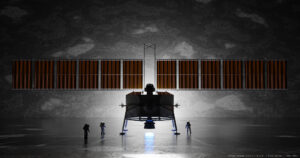Of the options we have, solar is a popular one given our familiarity with the technology here on Earth and its demonstrated in-space capabilities. It is relatively cheap, proven, and has seen deployment on the vast majority of missions into the solar system. However, the farther we journey from the sun and deeper we travel into space, the less sunlight we have to convert into energy. Unfortunately, even many of the places close to us that we are most interested in exploring (such as the permanently shadowed regions of the moon) have limited or no sunlight. To explore where sunlight is not always a constant, we need an alternative energy source.
Fission surface power (FSP) can reliably provide us with the energy needed in all of these different contexts. A fission-powered reactor can provide 150 kilowatts of electrical power and support a small lunar base for at least 10 years. This would allow NASA astronauts to create oxygen from regolith, provide electricity for other life-support systems, and enable any number of scientific missions. That same system could be scaled up to produce megawatts of electrical power for a large base capable of producing propellant, providing for increasingly larger crews, and enabling ambitious technology demonstrations and groundbreaking science missions.
Nuclear reactors designed for operation in space are well suited for these longer journeys as they are compact, energy dense, and scalable due to their modularity. However, what makes nuclear reactors an ideal power source for deep space exploration is their resilience. Space is the harshest environment known to humanity, but reactors designed for the lunar surface are capable of operating anywhere, at any time, for months and years on end.
The idea of sending a nuclear power system into space might sound fantastical, but it’s already more routine than many people realize. Nuclear power has been part of the United States’ space program since 1961, and since then, nuclear power systems have been incorporated into more than two dozen missions. The Voyager 2 probe launched by NASA in 1977 to study the outer planets and beyond famously carries a radioisotope thermoelectric generator that has allowed it to continue sending data back to Earth to this day. Most recently, NASA’s Perseverance rover has been partly powered by a similar but more modern radioisotope power system as it explores the surface of Mars.
As these new space nuclear technologies are being developed by the government and companies like USNC-Tech, we have to rigorously adhere to regulations related to the use of nuclear material. Part of this is ensuring our systems are proliferation resistant and the use of high-assay low enriched uranium (HALEU) is the first step to doing so. HALEU is an internationally recognized, proliferation-resistant form of nuclear fuel, far less capable of being diverted to illicit nuclear weapons programs, but which can still provide plenty of power efficiently over a long period of time. This capability has been proven by private industry, NASA, and the U.S. Department of Energy in the context of feasibility work showing similar or equivalent performance with systems that use weapons-grade nuclear fuel.
All of this will culminate in an exciting moment when American astronauts will be able to spend weeks or even months at a time on the moon. It is vital that we do so, not just for science, but also to ensure our continued presence in the solar system follows the principles for a safe, peaceful, and prosperous future detailed in the Artemis Accords. A permanent presence on the moon will put the United States and its allies in a position of strength to set the terms and conditions for that future. The U.S. and its allies, signatories to the Artemis Accords, are committed to these values, and must create conditions where those values can thrive and prevent other nations with different priorities from doing so for their own.
As Congress prepares NASA’s budget for fiscal year 2022, it has a valuable opportunity to ensure that America remains the world’s leader in sustainable space exploration by continuing to fund the development of advanced space nuclear technology. In recent years, Congress has supported and funded the development of nuclear thermal propulsion (NTP), a vital technology that would ferry astronauts to Mars in half the time of conventional propulsion systems, and I believe I speak for many in the space nuclear industry when I say that I am hopeful that this financial support for NTP development continues.
However, as nuclear propulsion systems become a reality, it is absolutely crucial that we also fund and develop the FSP systems that will enable humans to stay on the moon long-term once they arrive. With a relatively modest appropriation this year, NASA can seed the development of an FSP program that would result in a functional reactor demonstration on the moon within five or six years. When we combine this with the capabilities of the new launch vehicles and lunar landers being developed by companies in the United States and the prospect of delivering more than 5,000 kilograms to the lunar surface, we are looking at the ability to develop and deploy a game-changing capability, one that will enshrine the United States as the dominant spacefaring nation for decades to come.
This is an ambitious, but realistic timeline given the maturity of existing terrestrial reactor technology, and the meaningful progress already being made to adapt and advance that technology for use in space. Where previous lunar visits were measured in hours and days, investing in FSP now will give the next humans on the moon, including the first woman to walk on its surface, the energy required to survive, thrive, and build a permanent American presence on the moon.
Paolo Venneri is executive vice president of USNC-Tech, a technology development company established in 2019 as an independent subsidiary of Seattle-based Ultra Safe Nuclear Corp.



